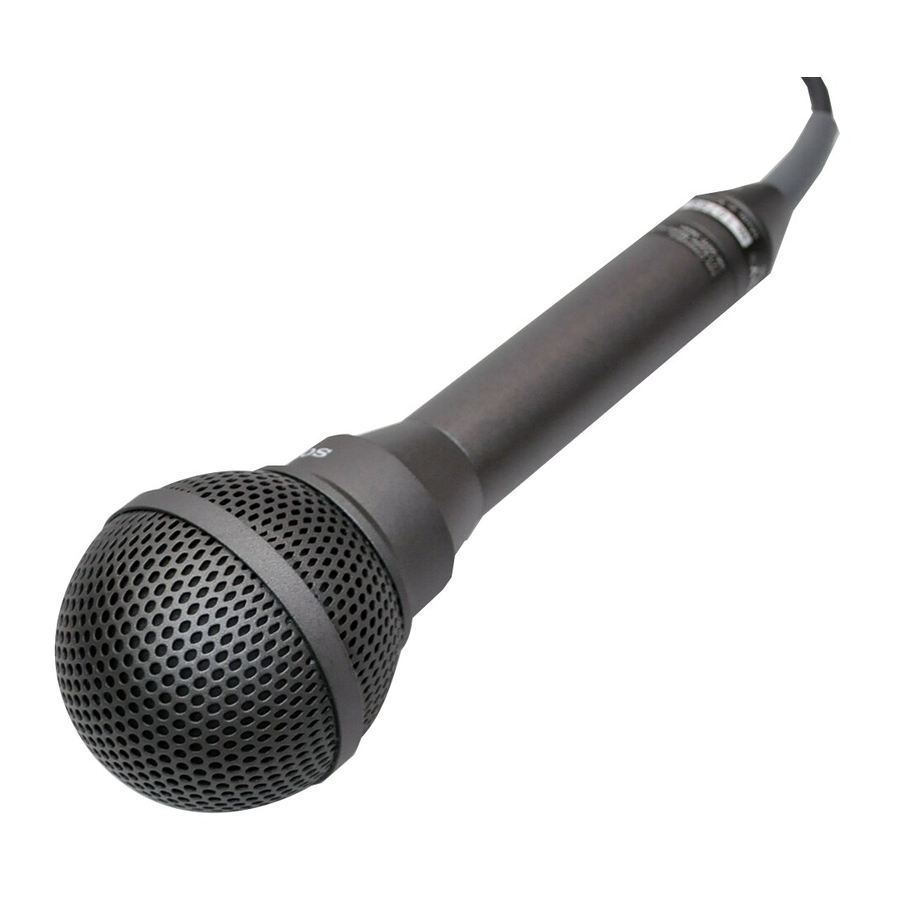
Advertisement

Before operating the unit, please read this manual thoroughly and retain it for future reference.
Features
- Omni-directional microphone suitable for outdoor use
This microphone provides rich and clear sound quality and protection against pop noise by the use of a wind screen. In addition, both microphone and wind screen are water resistant. - Dual-layer wind screen
The wind screen has a dual-layer aluminum structure and can be detached and reattached.
It functions to prevent pop noise and allow the microphone to be used to some extent in rain or wind without a reduction in performance.
Names and Functions of Parts (Fig. A)

(The numbers refer to the corresponding numbers in the figure.)
- Wind screen
Protects the microphone against noise caused by wind. - Microphone unit
- Grip
- Microphone cable
Outputs the sound recorded with the microphone.
About the wind screen
Attach the dual-layer wind screen when there is a strong wind that produces noise that adversely affects the recording. By attaching the wind screen, the noise caused by the wind is attenuated by 12 to 15 dB and the mid-range frequencies (2,000 to 4,000 Hz) are slightly emphasized, thereby allowing clear recordings to be made even under windy conditions.
Attaching the wind screen to the microphone (Fig. B)

Grasp the entire wind screen and press it straight onto the microphone until it reaches the place where the microphone becomes slender. Make sure the wind screen is firmly and completely attached. If the microphone is used with the wind screen imperfectly attached, it may affect the quality of the sound.
To detach the wind screen, pull it straight outward.
Using the microphone under rainy conditions
The microphone and wind screen are water resistant, allowing use of the microphone to some extent under rainy or windy conditions. However, water droplets adhering to the top of the microphone or wind screen may cause the performance of the microphone and quality of the sound to decrease. If this happens, point the microphone downward and with a good grip on it gently shake off the water. After use in rain, be sure to store the microphone in a dry place.
Notes on Use
- The microphone is delicate. Do not drop it or subject it to excessive shock.
- Keep the microphone away from extremely high temperatures (above 60°C (140°F)).
- If the microphone is placed to near the speakers, a howling effect (acoustic feedback) may occur. In this case, lower the speaker volume until the howling stops.
Specifications
General
| Type | Dynamic microphone |
| Output plug | Cannon-type plug (XLR-3-12C) |
| Microphone cable | 5.4 mm dia. (7/32 inch dia.), 2-conductor shielded cable, 3 m (9.8 feet) long |
| Finish | Matte metallic dark gray color |
| Mass | 330 g (11.6 oz.) (not including cable) |
| Dimensions | Microphone (top): Max. 34 mm dia. × 175 mm (1 3/8 inch dia. × 7 inch) Microphone (grip): 24.6 mm dia. (31/32 inch dia.) Wind screen: 62 mm dia. (2 1/2 inch dia.) |
| Supplied accessories | Operating Instructions (1), warranty booklet (1) |
Performance
| Frequency response | 40 Hz to 12,000 Hz |
| Directivity | Omni-directional |
| Output impedance | 400Ω ±20%, balanced |
| Sensitivity (deviation ±2 dB) | –54 dB (0 dB = 1 V/Pa at 1 kHz) |
| Noise | Wind noise*: 40 dB SPL or less Induction noise from external magnetic field: 5 dB SPL/1 × 10 -7 T (1 mG) or less |
| Operating temperature | 0°C to +60°C (32°F to 140°F) |
| Storage temperature | –20°C to +60°C (–4°F to 140°F) |
* Wind noise is the value measured by applying a wind velocity of 2 m/sec. (6.6 feet/sec.) to the microphone from all directions. The mean value is taken and converted to the equivalent sound pressure level. (0 dB = 2 × 10–5 Pa)
Directivity

Frequency response characteristics

Design and specifications are subject to change without notice.
Note
Always verify that the unit is operating properly before use. SONY WILL NOT BE LIABLE FOR DAMAGES OF ANY KIND INCLUDING, BUT NOT LIMITED TO, COMPENSATION OR REIMBURSEMENT ON ACCOUNT OF THE LOSS OF PRESENT OR PROSPECTIVE PROFITS DUE TO FAILURE OF THIS UNIT, EITHER DURING THE WARRANTY PERIOD OR AFTER EXPIRATION OF THE WARRANTY, OR FOR ANY OTHER REASON WHATSOEVER.
For the customers in Europe
This product with the CE marking complies with the EMC Directive issued by the Commission of the European Community.
Compliance with this directive implies conformity to the following European standards:
- EN55103-1: Electromagnetic Interference (Emission)
- EN55103-2: Electromagnetic Susceptibility (Immunity)
This product is intended for use in the following Electromagnetic Environments: E1 (residential), E2 (commercial and light industrial), E3 (urban outdoors), E4 (controlled EMC environment, ex. TV studio).
The manufacturer of this product is Sony Corporation, 1-7-1 Konan, Minato-ku, Tokyo, Japan.
The Authorized Representative for EMC and product safety is Sony Deutschland GmbH, Hedelfinger Strasse 61, 70327 Stuttgart, Germany. For any service or guarantee matters please refer to the addresses given in separate service or guarantee documents.

Documents / ResourcesDownload manual
Here you can download full pdf version of manual, it may contain additional safety instructions, warranty information, FCC rules, etc.
Download Sony F-115B - Dynamic Microphone Operating Instructions
Advertisement














Need help?
Do you have a question about the F-115B and is the answer not in the manual?
Questions and answers